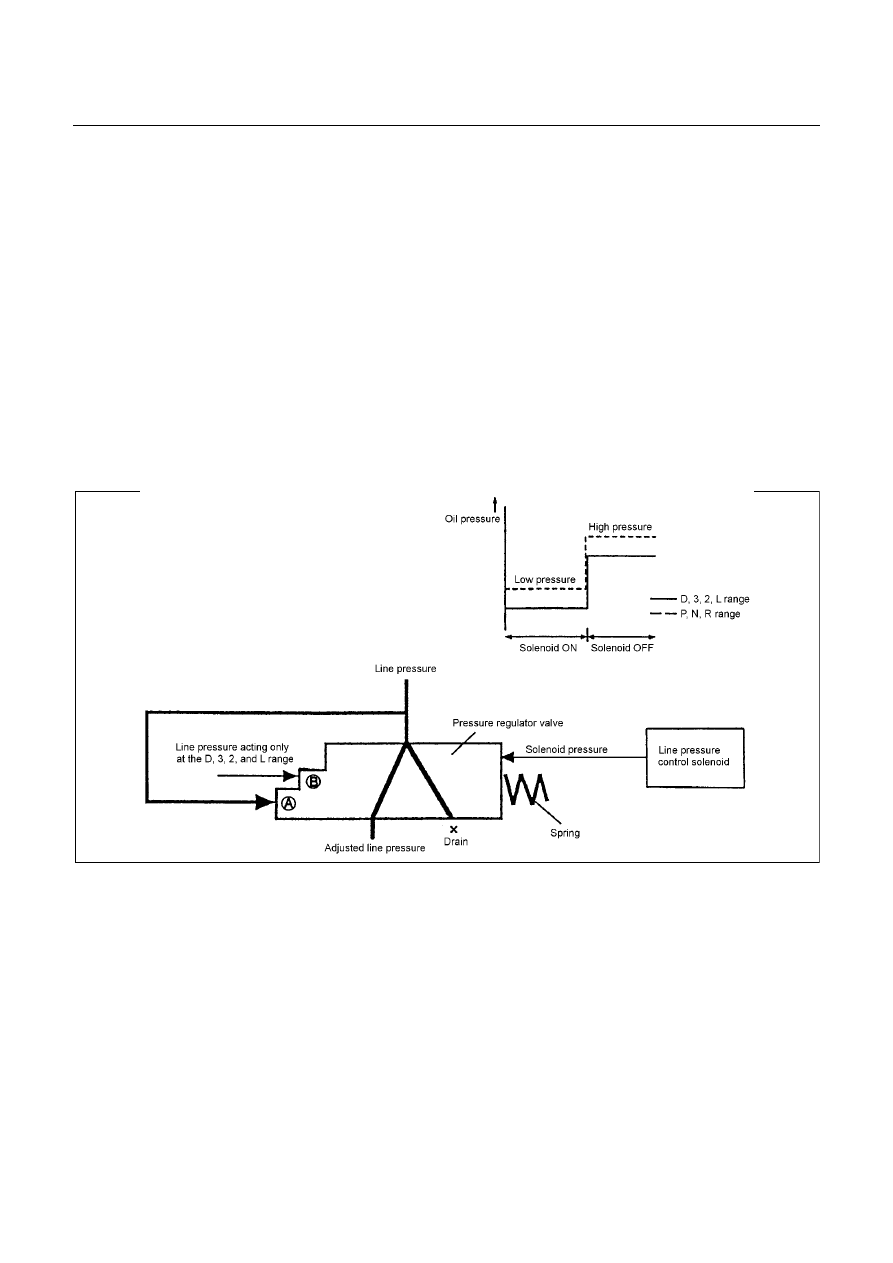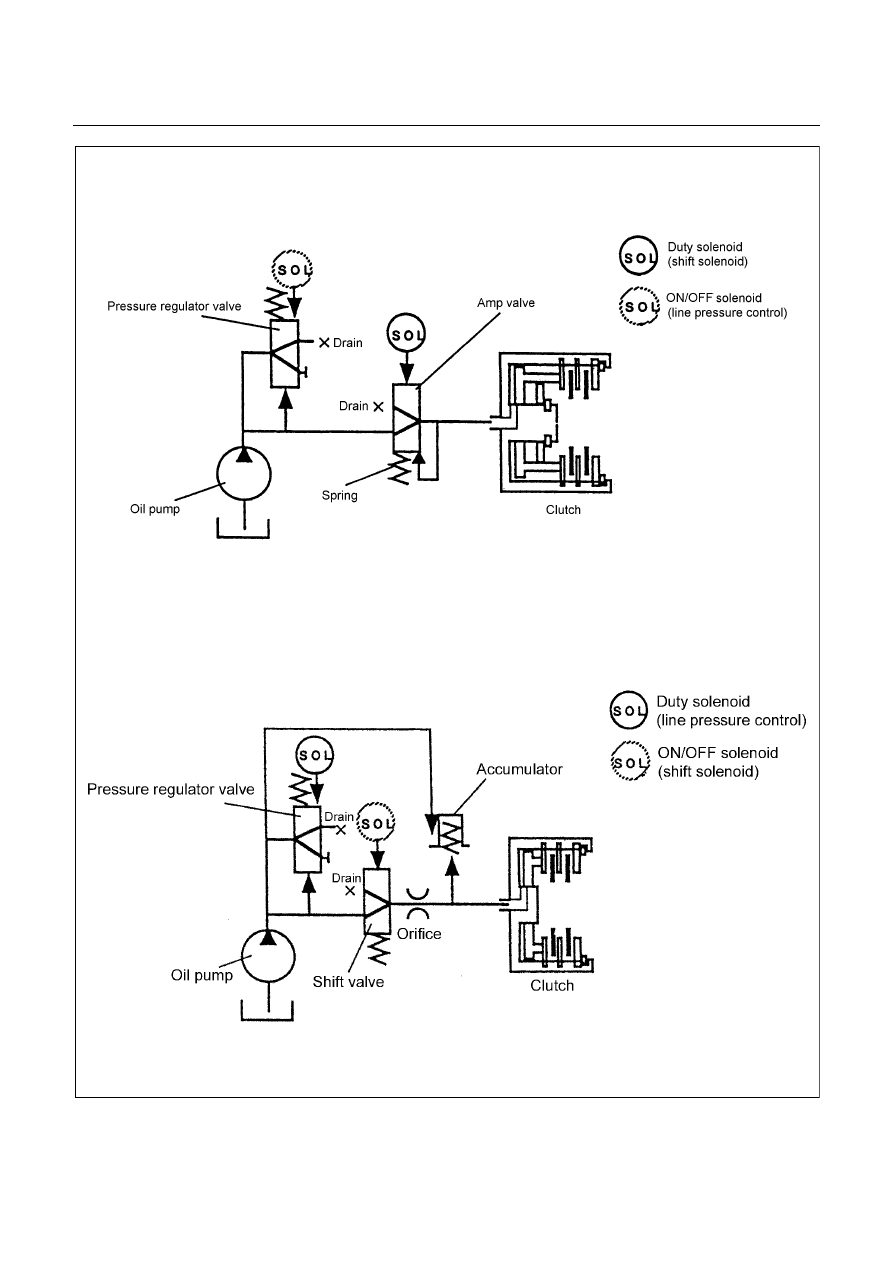Isuzu D-Max / Isuzu Rodeo (TFR/TFS). Manual — part 1733

CONSTRUCTION AND FUNCTION 7A1-29
CONTROL ITEM, INPUT AND OUTPUT
Control item
Item
Line
pressure
control
Gear
shift
control
Shift
pattern
selection
Lock-up
control
Direct
electronic
shift
control
(DECS)
Learning
control
Fail-safe
function
Self-
diagnosis
function
Speed sensor
Turbine sensor
Engine speed sensor
Brake switch
Inhibitor switch
Mode select switch
4L switch (4WD Only)
ATF thermo sensor
High clutch oil pressure switch
2-4 brake oil pressure switch
Low & Reverse brake oil pressure
switch
In
put
Throttle position sensor
Line pressure solenoid
Low clutch solenoid
High clutch solenoid
2-4 brake solenoid
Low & Reverse brake solenoid
Lock-up solenoid
Shift pattern indicator lamp
ATF temperature indicator lamp
O
u
tput
Check trans indicator lamp

7A1-30 CONSTRUCTION AND FUNCTION
LINE PRESSURE CONTROL
•
Either the throttle opening, vehicle speed, turbine rotational speed, ATF temperature or speed-change
range signal appropriate under the situation is issued from the TCM. The ON/OFF type line pressure
solenoid is actuated and switches the line pressure to high or low pressure.
•
The line pressure generated by the oil pump acts on the point A of the pressure regulator valve. When
the pressure control solenoid is turned ON by the signal from the TCM, the solenoid pressure does not
act. The line pressure is adjusted to match the spring force acting on the right side of the pressure
regulator valve.
•
When the pressure control solenoid is turned OFF, the solenoid pressure acts so that the line pressure is
adjusted to match the spring force acting on the right side of the pressure regulator valve.
•
As a result, the line pressure is adjusted to be low when the pressure control solenoid is ON and to be
high when the pressure control solenoid is OFF.
•
In the D, 3, 2 and L range, the line pressure through the oil pressure circuit acts onto the point B of the
pressure regulator valve and the pressure regulator valve moves so as to increase the pressure to be
drained, so that the line pressure is adjusted to be lower than the P, N, and R range by the difference of
area at the point B.
Figure 50. Line Pressure Control
LOCK-UP CONTROL
•
The lock-up solenoid adjusts the pressure and controls the lock-up based on the pre-set lock-up point,
according to the vehicle speed, throttle opening, engine rotations, turbine rotations and ATF temperature
input signal, based on the signal from the TCM.
•
Smooth lock-up control is employed to engage or disengage the clutch smoothly at the time of lock-up.
•
When the oil temperature is low (below 20
°
C) or high (over 128
°
C), lock-up is disengaged even though
the vehicle is at the lock-up speed.
•
The lock-up is disengaged also when the throttle is closed.
•
When the TCM determines the lock-up engagement, the DUTY ratio to supply power to the lock-up
solenoid is gradually increased (5% to 95%) and the oil between the lock-up piston and converter cover is
gradually
drained.
As a result, the lock-up piston is fitted slowly under pressure to the converter cover securing smooth lock-
up engagement.

CONSTRUCTION AND FUNCTION 7A1-31
Figure 51. Lock-up Control
DIRECT ELECTRIC SHIFT CONTROL (DESC)
Feature
•
Based on the each switch signals (low & reverse brake pressure, 2-4 brake pressure & high clutch
pressure) and sensors signals (turbine sensor, speed sensor, engine speed signal & throttle position
signal), duty cycle type solenoid adjusts the clutch pressure to match the engine load and vehicle
traveling condition. By this result, controlling the engagement and disengagement of the clutch and brake
pressure is directly and accurately controlled via TCM, which is not realized in previous accumulator type.
Operation
•
Instead of the previous system (on/off type of shift solenoid and shift valve), the combination of duty cycle
type solenoid and amplifier (Amp) valve are used to adjust the clutch pressure to match the engine load
and vehicle traveling condition based on the signal from the TCM, and the pressure switch provided in the
oil passage of the control valve transmits the oil pressure condition at that time to TCM, thus controlling
the engagement and disengagement of the clutch and brake directly and finely.
•
When the gear is shifted from the 2nd to 3rd, 3rd to 4th (O/D), 4th (O/D) to 3rd and 3rd to 2nd, the clutch
pressure on the engagement side and that on the disengagement side are simultaneously controlled.
As a result, engine racing or clutch drag is prevented securing smooth and quick speed change response

7A1-32 CONSTRUCTION AND FUNCTION
Direct Electric Shift Control
Previous Model
Figure 52. Direct Electric Shift Control (DESC)

Нет комментариевНе стесняйтесь поделиться с нами вашим ценным мнением.
Текст